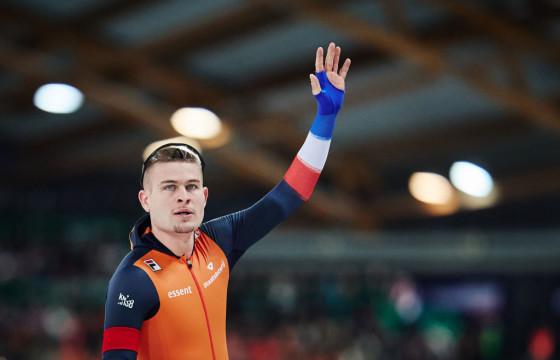SPEED SKATING
Speed Skating vs Roller Skating vs Short Track: what’s the difference?
27 Nov 2024
Speed Skating, roller skating and Short Track are all different specialisms – but the three are very much intertwined. They require similar technical skills, and many athletes have swapped between the sports – and some have combined two, even all three. How do they relate to each other, and what are the key differences?
Speed Skating: the fastest
Speed Skating developed from prehistoric sliding on animal bones to a competitive sport with its first official World Championships in 1893. The bones were replaced by blades and the sport developed over time, with improved clothing, technical equipment and rinks leading to a dramatic increase in speed.
The first 500m world record was registered in 1891 was 50.8 seconds (average speed 35.4km/h), while the current 500m world record is 33.61s (53.6km/h). This makes Speed Skating the fastest of the disciplines: the 500m world record in Short Track is 39.505s (45.6km/h), and in inline, it’s 39.931s (45.1km/h).

Jordan Stolz (USA) won both 500m races at the 2024/25 season-opening ISU World Cup Speed Skating in Nagano, Japan © ISU
Short Track: the youngest
While Mass Start ice races were held in the early 20th century, Short Track didn’t become an ‘official’ sport, under ISU sanction, until 1967, making it the youngest of the three sports.
Its first World Championships were held in 1976, and Short Track featured on the 1988 Olympic program as a demonstration sport, before being added as a full sport in 1992.

Jens Van 't Wout in action in Montreal, Canada at the inaugural ISU Short Track World Tour event © ISU
Inline: The summer alternative
The earliest known roller skates date back to 18th century Europe, but became popular with mass production in the 1880s. Its international federation was established in 1924 and became World Skate in 2017 (which also presides over skateboarding, rink hockey, and other small-wheel sports).
Skateboarding joined the Olympic program for Tokyo 2020 – and many would love to see inline follow. Yet there are numerous world inline champions who have also competed on the ice and even became Olympic champions. Beijing 2022 500m champion Erin Jackson (USA) and Mass Start Olympic champion Bart Swings (BEL) are the latest.

Summer inline skating (photo: free licence)
Combining sports
Several athletes have combined Long Track and Short Track careers. Jorien ter Mors (NED) won medals in both at the PyeongChang 2018 Olympic Winter Games. Olympic Long Track Team Pursuit champions Ivanie Blondin and Valérie Maltais (CAN) both have a Short Track background. Olympic gold medalists in Short Track Suzanne Schulting (NED) and Arianna Fontana (ITA) have both recently begun competing in Long Track.
“It has been challenging,” Fontana said. “There is lots of travel, and trying to fit in and find an equilibrium between Short Track and Long Track is hard. The training is not easy. But it is a fun new challenge, and right now I am seeing only benefits.”

Arianna Fontana of Italy © ISU
Technical differences
Long Track skaters use a clap skate with a hinge, which allows the skater to extend the ankle further. This works well on the long straights and wide corners of a 400m track, but it’s not fit for the smaller rink – Short Trackers have fixed blades to make sharper turns at high speed in tight corners.
Inline skaters, meanwhile, can use a ‘double push’ – a highly technical move that involves both edges and doesn’t work on ice.
Joey Mantia (USA), an inline world champion turned Long Track medalist, admits: “I had to detrain myself not to double push. Still, if you watch closely, you can see that bob up and down a bit. There’s a sweet spot in inline skating. Ice skating for me is not natural at all.”

Joey Mantia (USA) © ISU
Time trial versus pack-style
Race formats differ, too. In Speed Skating the usual format is time trial. There are five classical distances: 500m, 1000m, 1500m, 5000m and 10,000m.
Skaters compete in pairs, each athlete starting in their own lane and changing lanes each lap. When all pairings have raced, the fastest time wins.
In later years, new formats have been added to Long Track, such as Team Pursuit, Mass Start, Team Sprint and Mixed Gender relay.
In Short Track, races are pack style, typically with four to six skaters. A competition typically comprises prelims, heats, quarterfinals, semifinals, and an A final and a B final. Individual distances are 500m, 1000m and 1500m, while Relays are contested over 3000m (for women), 5000m (men’s) and 2000m (for mixed teams).

Skaters compete in the Men's 5000m Relay at the second Short Track World Tour event of 2024/25 in Montreal, Canada © ISU
Inline skating has both time trial and pack-style races, in many different distances. Most racing is pack-style, and includes knockouts, points races, eliminations and even marathons. Racing is done on both rinks and public roads.
Long Track Speed Skating has the comparable Mass Start – which suited Mantia, thanks to his inline background. “I had to learn how to put the maximum effort in a race over a distance of 1500m or 5000m,” he said. “The Mass Start is right in my wheelhouse.”
World-class competitions
The Long Track season typically comprises six World Cup events between November and March, while Short Track has a six-event World Tour from October to February. Both sports usually have World Championships in March; the Olympic Winter Games are their pinnacle.
Inline speed skating has held an annual World Championships since 1937. Since 2017 the World Championships are part of the biannual World Skate Games.







